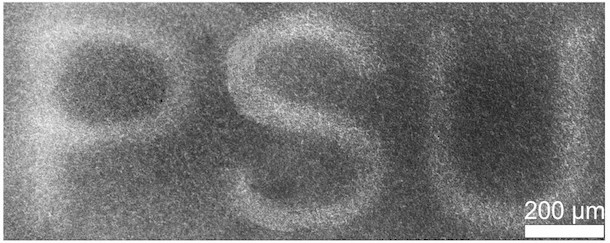
A hydrogel undergoing programmed degradation with the PSU pattern
A two-step process for better delivery of medicine
5/8/2019
A team of Penn State researchers have developed a medical hydrogel that enables programmable degradation via two separate trigger factors, such as light and pH, which could improve drug delivery, cell engineering, and regenerative medicine.
“When we design materials to be used for human health such as drug delivery, in general you want the materials to disappear eventually to release drugs, such as with a capsule or a matrix,” Yong Wang, professor of biomedical engineering and primary investigator in the study, said. “But the problem is, you don't want the materials to disappear too quickly because the functionality of the material won't be fully realized. That is the reason why you have to control the degradation.”
The solution proposed by Wang’s lab and published in Angewandte Chemie International Edition is controlling the degradation by using a double-locked domain (DLD). A DLD is a molecular structure with two functional units that are activated by two different triggers, such as first exposing the material to light for the first trigger, then changing the pH with something acidic for the second trigger. In this case, the first trigger would cause changes in the material via molecular conformation to enable degradation to begin and the second trigger would begin the actual degradation. Previously, a single trigger was used, but Wang notes that using a DLD is more effective.
“You can control when the degradation will happen with a single trigger in theory, but the problem is the human body is very complicated, so it may not be as effective,” Wang said. “It's like if someone wants to break into your home, if you have one single lock, you might not be able to protect your home. So you need a dual smart-door lock. The DLD is also similar to a two-factor verification for Internet security. If you only use light or pH, that’s like using just one password and it doesn't work. And if you reverse the password sequence, it won't work either. It has to follow that procedure.”

Double-locked molecular domains for programmed degradation
This method, Wang says, could enable better drug delivery in several ways. For example, doctors use a single trigger, such as an ultrasound, to activate nanoparticles in a cancer drug to reach a tumor. However, this single trigger often will not result in the nanoparticles reaching inside the tumor cell. A second trigger, such as pH, can enable the treatment nanoparticles to work inside the cancer cell.
In addition, DLD allows for more control of drug delivery. For example, a pH-based first trigger, followed by light as the second trigger to release medicine for a skin disease, could enable controlling treatment by simply covering or exposing a section of a patient’s skin area.
Doctors could also use DLD-programmed molecular triggers to enable patients to receive two different drugs from one pill.
“Some patients have to take multiple medications for multiple diseases,” Wang said. “Using this two-trigger system, you take just one pill, and the first molecular trigger is programmed to release the drug in one hour, and the second drug is timed to be released in four hours. Thus, patients can get both short-acting and rapid-acting medicine.”
Wang notes that while the DLD concept has been shown to be effective, there are limitations to practical real-world applications. Currently, the two triggers are light and pH, so DLD is limited due to light penetration.
“Right now, I can think of two applications,” Wang said. “One is for cancer and the other is for the treatment of skin-related disease. For cancer treatment, if it is not a skin-related cancer, then light penetration is a bigger challenge.”
Wang’s research was supported by the National Science Foundation and the National Heart, Lung and Blood Institute of the National Institutes of Health. Other researchers on the project include Jinping Lai, biomedical engineering research associate; Lidya Abune, bioengineering doctoral candidate; and Nan Zhao, bioengineering doctoral candidate.



